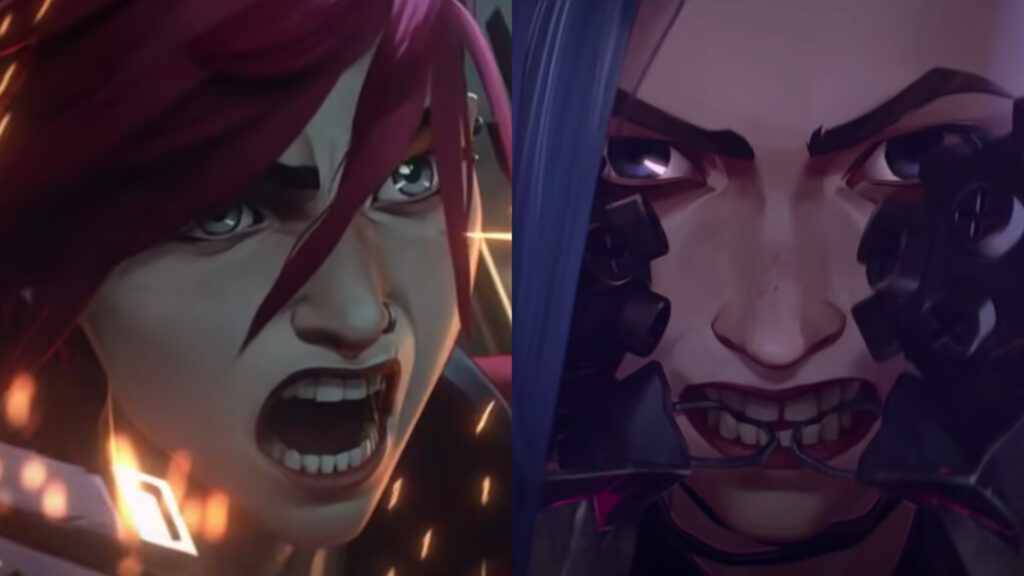“Not bad… at least better than the Worlds 2021 theme song.”
When “Enemy” by Imagine Dragons featuring J.I.D was released more than a week before Arcane’s debut, that was my first thought after my first listen. It didn’t feel like their Worlds 2014 “Warriors” level, but at the same time, it still sounded better than majority of subsequent Worlds songs.
When November 7, 2021 rolled around, I finally got to watch Arcane’s debut Act 1, and ended up putting Enemy on repeat for an hour.
After Act 2, I hit the repeat button again on Spotify and let it play for two hours while I packed my bags for Undercity Nights.
In the official Arcane opening song music video, Riot Games went all out to animate every single Imagine Dragons band member, placing them in the world of Runeterra, and later invited them to perform at the Worlds 2021 opening show.
Most recently, Imagine Dragons and J.I.D performed Enemy at the MTV Europe Music Awards (EMA) 2021, bringing Arcane to the mainstream.
What’s even cooler however, is discovering that Enemy is only composed of two chords.
- Arcane: Every League of Legends Runeterra region referenced in the series
- Here’s what happened off-stream at Riot’s invite-only Undercity Nights Arcane event
Yes, you read that right, Enemy by Imagine Dragons is only made up of two chords
How is this possible?
The absolute majority of hit songs have at least four chords. This is the minimal magic number that allows musicians to compose enough variations, expressions, transitions, and combinations to keep a song harmonically interesting.
Very few songs, what more hit songs, lie in the two chord song category. Famous ones include “Eleanor Rigby” by The Beatles, “Born In The USA” by Bruce Springsteen, and “Lively Up Yourself” by Bob Marley.
Enemy is set in the key of B minor, and Imagine Dragons only uses two chords throughout — F# minor, its fifth, and G major 7, the sixth chord in this key — to produce a catchy Arcane opening song that became a music hit.
How?

Imagine Dragons’ Enemy uses four rhythmic patterns and plays around with minor 3rd intervals
“Look out for yourself!” the opening song begins.
We’re then greeted by the lead vocals and drums, with soft guitar plucking in the background.
Verse
I wake up to the sounds
of the silence that allows
For my mind to run around,
with my ear up to the ground
I’m searching to behold
the stories that are told
When my back is to the world,
that was smiling when I turned
The verse has a distinct rhythmic pattern comprising semiquavers, laid out in a descending melodic pattern. Each phrase takes on one of the two chords, and only uses two repeated notes that end on a minor 3rd.
In true Imagine Dragons fashion, the band also marked the end of each bar with rhyming words, punctuated with alliteration: Sounds, silence, allows. Run, around, ear, ground. To, stories, that, told.
Pre-chorus
Then comes a highly contrasting pre-chorus. Here, the rhythm slows, the words are dragged out, building up anticipation. In this transition, the bass guitar starts to make its presence heard.
Tell you you’re the greatest
But once you turn they hate us
Four strong crochet beats are used in a descending melody to create an impact.
You also have to appreciate how “greatest” and “hate us” is an intentional partial rhyme, differing from the verse. This change is paired with a dissonant change at the end of the phrase, where a major 3rd, instead of minor, is deployed, which creates an unsettling feeling within the listener.

Chorus
Boom! The height of the Enemy is punctuated with a synthesized burst at the start and end of each phrase. And of course, another distinct rhythmic change.
Oh, the misery
Everybody wants to be my enemy
Spare the sympathy
Everybody wants to be my enemy
Look out for yourself
My enemy
Look out for yourself
But I’m ready
Alliteration is used throughout the opening song, but it is especially noticeable in the chorus because the same sound is repeated throughout: Misery, everybody, enemy, sympathy.
Energy is further built through the chorus’ rhythm and melody. After two downward patterns, the first melody goes up and down, followed by a line of quick semiquavers, almost like a trill.
Then, out of nowhere, the first triumphant upward major 6th interval (be, enemy).
Still, if you were hoping for a resolution, I’m afraid there’s none because this opening song never actually plays its root B minor chord. The chorus ends with a shoutout (look out for yourself), and a descending low octave “enemy-y-y-y” mimicking the pre-chorus.
Outro
After J.I.D’s rap, the chorus is repeated and leads to the outro.
They say pray it away, I swear, I’ll never be a Saint, no way
My enemy
They say pray it away, I swear, I’ll never be a Saint
Look out for yourself
The outro’s rhythmic and melodic pattern adopts elements of everything that came before, and goes back to minor 3rd phrases.
Then finally, a minor 2nd interval (a Saint) ends the song before it goes full circle with the repeated “Look out for yourself!”.
Two things happen when you watch Arcane. The more you discover Arcane’s story, the more it adds layers of meaning to Enemy. At the same time, the more you listen to Enemy, the more you realize how brilliant the lyrics are, where the same words can be used to describe different characters who find themselves in very different situations.

The unresolved B minor key makes perfect sense as Arcane’s opening song, where each episode leaves you hanging and wanting more.
Despite only using two chords, Imagine Dragons composed it in a way that distinguishes each section. At the same time, Enemy’s combined musical gestures and lyrical layers come together to create unity within that variance.
Due to the unresolved music intervals, the song makes you feel a little disconcerted, a little aggravated, a little distressed at times, just like its characters. Tension builds throughout, without conclusion, much like life.
READ MORE: Arcane soundtrack: Every song featured in the League of Legends anime


